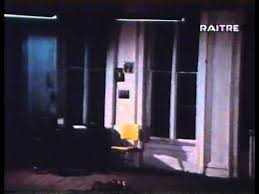Wavelength
Rarely have
I met a movie with this much praise. Wikipedia: “Wavelength is often listed as
one of the greatest underground, art house and Canadian films ever made”. The
Book: “… a vital, important and necessary work”. Both continue to reference a
lot of praise from elsewhere.
I can only
think, wow, this is going to be interesting.
When I was
a child television would only be available certain hours each day. Outside that
time there would only be a test signal. This would be a static image with a lot
of colors, a digital watch and a constant (and hideous) narrowband tone. You
could not look and listen to that for long, but it was used to ensure the fine
tuning of the pick up of the channel (a manual affair back then). This is also
a fairly precise description of “Wavelength”, except this goes on for 45
minutes, longer than I have ever endured the test signal.
The camera
spends 43 minutes looking into a room slowly zooming in on a picture on the
opposite wall, while a narrowband tone gradually increases in frequency from 50
Hz to 12 KHz.
Yeah, that
is about it.
Apparently,
a murder takes place in the room, but I never noticed.
Ah, I almost
forgot, in the beginning, before the tone starts, we get a highly distorted version
of Strawberry Fields.
Now I am
supposed to explain why this is a super important movie and a vital and
necessary watch, but I am stunned for words. I simply have no idea. Yet, having
an empty shell it is very easy to fill meaning into it. As we do not understand
we can try to give it meaning and make this scene full of nothing express
something profound. Beside the utter boredom watching this movie I was thinking
of being sucked into a black hole, that gradually the world gets smaller and
smaller, eventually becoming a singularity. Why not?
But then I
could also get some meaning out of the television test signal.
“Wavelength”
I would only recommend to those who love obscure art and masochists. There is a
reason we try to avoid narrowband tones in machinery.

I hate to be that guy, but...I didn't really have a problem with Wavelength.
ReplyDeleteSeriously.
I know your position on this movie from your review and I do respect that even it I do not share it. Art movies like any art are personal and so we find our own meaning. For me it eluded me and instead became annoyingly boring.
DeleteI'm in the same boat as Steve; I actually ended up enjoying the 45 minutes or so I spent with Wavelength. I was able to put myself in the mindset of a cinephile in the 1960s who happened upon this for the first time, and the sheer difference of it seemed to rattle me in a good way. This shouldn't make you feel like there was something there that you just didn't get, though, because I readily acknowledge that the only reason I enjoyed this one was because of whatever my mind was fabricating into the empty canvas that is this film during my watch of it, as I tried to get across in my own review. Whatever that random string of thought processes was, I happened to appreciate it, and I liked that Wavelength brought that out of me, though again in all fairness it is only because my mind was filling in the blanks of the film itself that that ended up happening.
ReplyDeleteAlso, if my memory is correct (it's been a while since I've seen this), the zoom-in to the picture on the wall that serves as the main movement of the film itself ends up simply cutting to the end of the movement to show the picture near the end of the short, almost as if the director got impatient with his own camerawork. I was a little bothered that the whole point of the central aspect of the film, the zoom-in, ends up short-shrifted by the fact that the film cuts to the end of it instead of having the whole thing as a single shot.
I can see how this can induce a trance. I suppose on the right day it could do that for me as well, but this was just not one of those days.
Delete